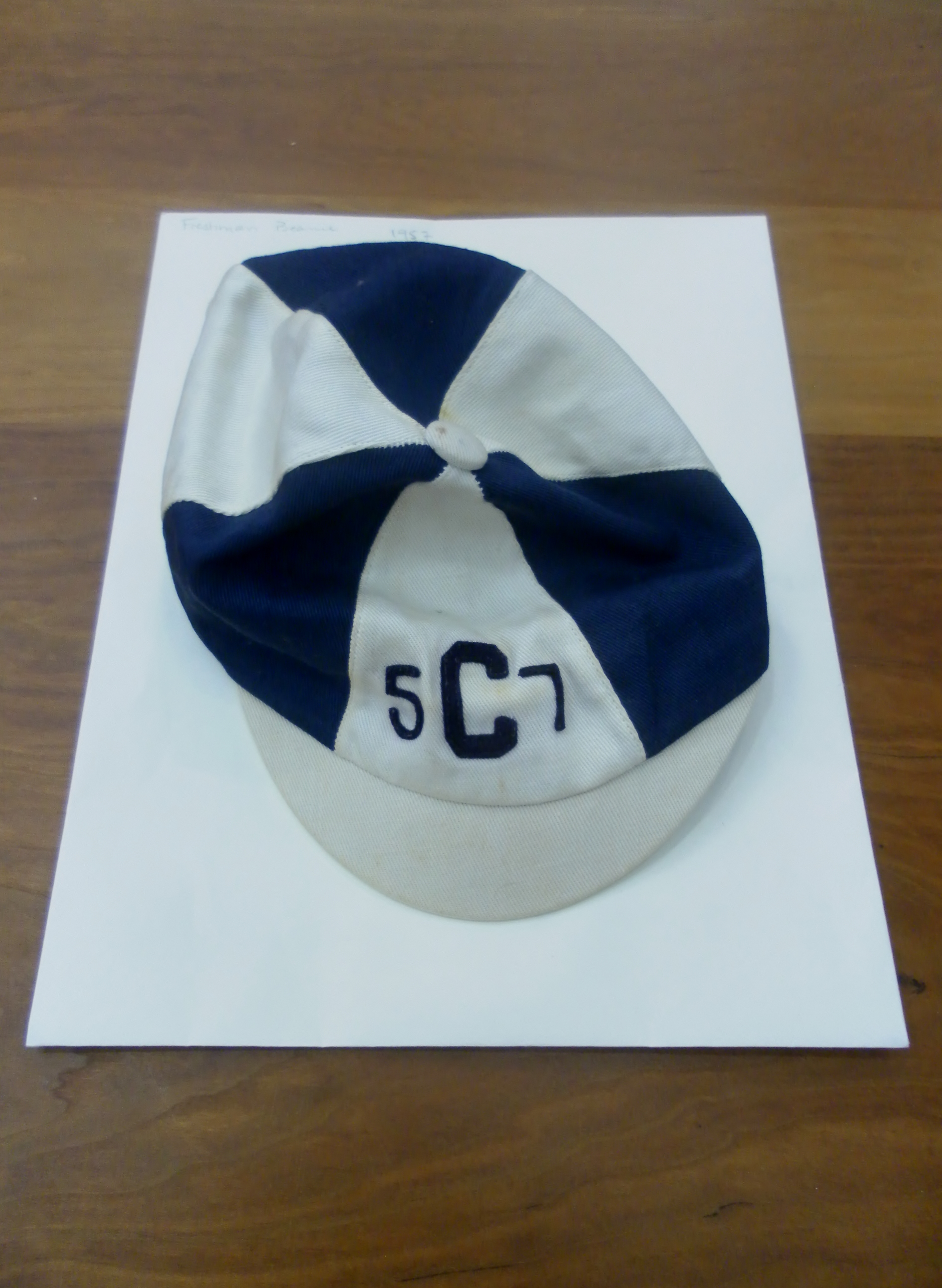Carey MacDonald is an undergraduate Anthropology major and writing intern. In her new series Through the Lens of an Anthropologist, Carey analyzes artifacts found in the collections of Archives and Special Collections.
Sociocultural traditions pervade the human experience and provide a reliable mechanism for social cohesion. It is commonly thought, though, that traditions are strictly old manifestations of an earlier cultural context, when, in actuality, they evolve and create a distinct reality for each successive generation.
Yet traditions only evolve and persist for as long as their adherents maintain, reproduce, and reinforce them in their culture. Such is the case of the college freshman beanie, a colored cap that freshmen were required to wear as a form of initiation into the greater university social setting. According to the University Archivist Betsy Pittman, the tradition of wearing this cap was ubiquitous among American universities during the late nineteenth and twentieth centuries. For younger generations though, this tradition no longer exists in the form that it once did, although there certainly exist other freshman initiation rites, particularly within the scope of Greek life, honor societies, and sports teams. An example of the UConn freshman beanie tradition comes from the University Memorabilia Collection.
The crown of this beanie resembles a circus tent: it is patterned by six alternating blocks of navy blue and white (university colors) and is held together in the center by a white fabric-covered fastener. An insignia of ‘5 C 7’ is embroidered on the front of the cap above the narrow, white brim. ‘5’ and ‘7’ are placed on either side of ‘C’ in a thin, navy blue felt font and represent that freshman class’s graduating year – in this case, the class of 1957. ‘C’ is sewn in a larger, thicker, navy blue felt font and most likely represents Connecticut. Also important is the name Eugene H. Starger, which is handwritten in what appears to be thin permanent marker or black pen on the inside rim of the hat. It seems that Eugene got a lot of use out of his beanie since it is stained; it is apparent that he wore this beanie more than once, as it was a necessary part of his attire for at least some time.
We see the first evidence for the freshman beanie tradition in a student handbook from the academic year of 1921-22 called The Handbook of Connecticut Agricultural College. In the handbook’s “Message of ’24 to ’25” – as it was written by the class of 1924 to the incoming class of 1925 – we see abrupt, intimidating, student-to-student language used to enforce the university’s traditions:
As your infantile brain could not possibly assimilate the significance of a proper beginning, tradition places the burden of guiding you through this, your first year at C.A.C. on the broad, capable shoulders of the Class of 1924…Transgress sacred College Tradition and never…will the haunting memory cease to picture that terrible night when you so unexpectedly disturbed the Waters of Swan Lake.
This message is clearly intended to ensure that no freshman would ever “transgress sacred College Tradition,” capital letters and all, because if they did, they’d be punished and thrown into the lake. The handbook continues by giving freshmen explicit instructions for using the beanie. They were to wear this distinct cap and conform to the rules. Sophomores were to distribute the caps and enforce the rules.
Thirty-two years later, the student-written Husky Handbook of 1953-54 – the same year that Eugene H. Starger was a freshman – requires freshmen to wear their purchased beanie until the ‘season’ is over. The season ended if the freshmen won the Frosh-Sophomore Rope Pull contest across Mirror Lake during the first month of school, but if the sophomores won, then the freshmen would have to wear their beanies until Thanksgiving break.
Most importantly, the handbook explains the overall significance of wearing the beanie: the upperclassmen wanted to know who the freshmen were so that they could meet and help them more easily. Interestingly, this section ends by saying, “Wear your Beanie with pride, because we are proud to number you as ‘one of us.’” Betsy Pittman expands on this notion by describing that the ‘controlled ritual’ of wearing the freshman beanie signaled to others one’s commitment to the university, its culture, and its people. She also remarks that since the upperclassmen had to wear a beanie during their first year too, the student body in general had this experience to which they could all relate. This would, in effect, foster a beneficial sense of community, and ultimately, as Pittman says, the “beanie is a physical manifestation of that community.”
Carey MacDonald, writing intern

